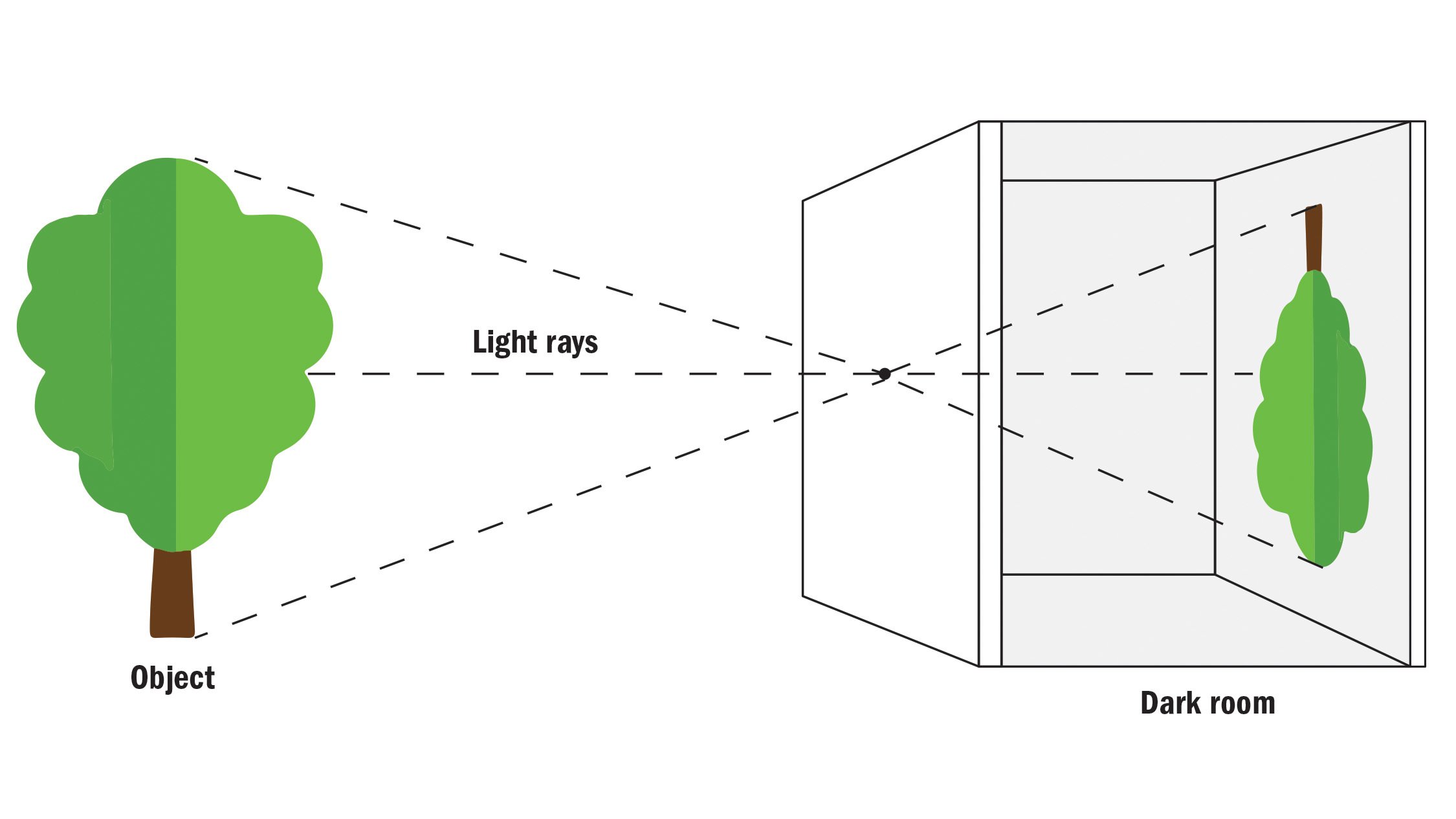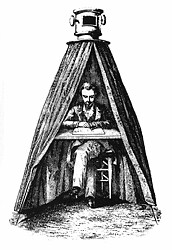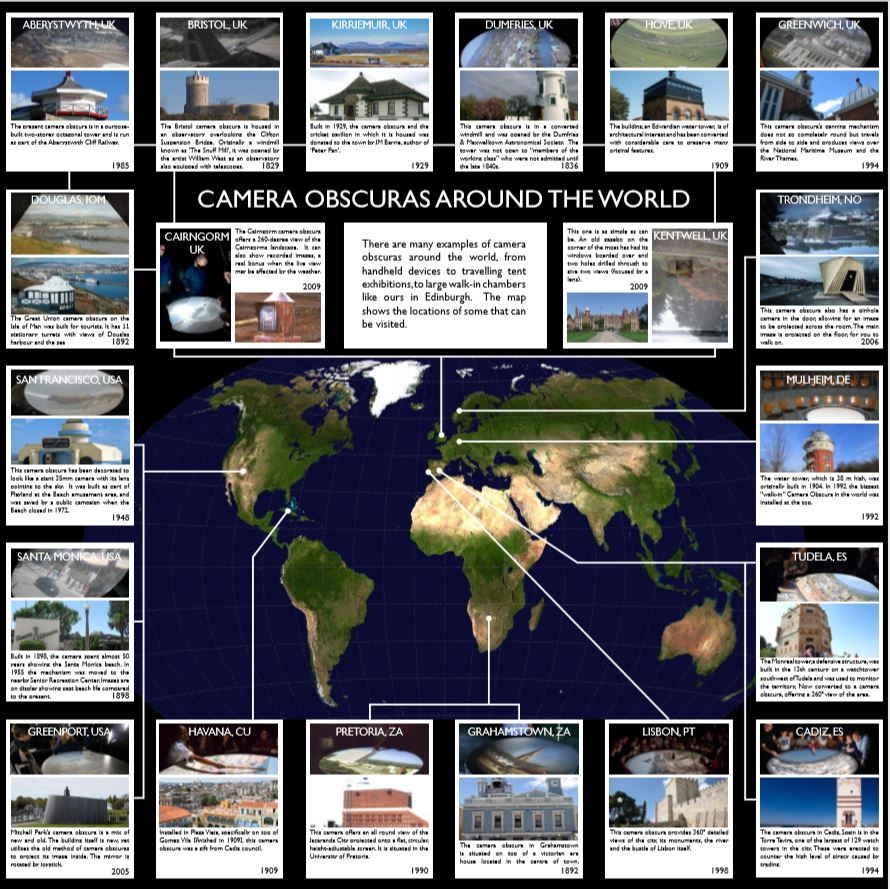When Was The Camera Obscura Invented
Camera obscuras through time
Have you e'er wondered what a camera obscura actually is and where the idea came from? Well, y'all've come up to the right place! We're going to peer through the lens of time and take a look at the history of the famous photographic camera obscura.
How it works
In its simplest grade, a camera obscura is a dark room with a modest hole in one wall. When it's bright outside, light enters through the hole and projects an upside down epitome of the exterior world onto the wall opposite the hole. Did yous know that the name photographic camera obscura is really Latin and translates to "dark chamber"?
Our Camera Obscura is a little more than complex than this, but it's based on the aforementioned principle. We accept a mirror at the pinnacle of our tower which is angled to reflect light downwardly a large tube which contains three lenses. These lenses focus the light onto a white wooden table, projecting an image of the view outside. The mirror tilts and rotates allowing us to see a 360-degree view of Edinburgh and the lenses allow the states to see the image the right fashion up.

How information technology began
Our Photographic camera Obscura isn't the merely one in existence. In fact, camera obscuras date back to as far as 400BC, possibly even earlier records existed.
The earliest known written business relationship of a photographic camera obscura was provided by a Chinese philosopher called Mo-tzu (or Mozi) in 400BC. He noted that light from an illuminated object that passed through a pinhole into a dark room created an inverted epitome of the original object.
In the 4th century BC, the Greek philosopher Aristotle realised that a partial eclipse could be viewed by looking at the footing below a tree. The crescent shape of the partially eclipsed sun projected onto the ground through the holes in a sieve and through the gaps between the leaves assuasive him to view it safely.
Several other scientists experimented with light passing through a modest hole, but information technology wasn't until the 11th century that a viewing screen was used to run across the inverted paradigm. Alhazen (or Ibn al-Haytham) is said to accept actually invented the camera obscura, equally well as the pinhole photographic camera which is based on the same thought. He carried out experiments with candles and described how the epitome is formed by rays of light travelling in straight lines.

Four centuries later on Leonardo da Vinci (1452–1519) suggested that the human centre is like a photographic camera obscura. He went on to publish the starting time clear description of the photographic camera obscura in Codex Atlanticus (1502).
Upward until this bespeak in time, the photographic camera obscura had been described, but it wasn't really improved upon until an Italian scholar named Giambattista della Porta (1535 - 1615) came along and added a concave lens near to where low-cal enters the pinhole.
A few years afterward Johannes Kepler used the term "camera obscura" for the first time in 1604. Kepler used the photographic camera obscura for astronomical applications and created a portable version that he carried around with him as a tent for surveying Upper Austria.

And then at present the camera obscura had been described, named and even improved upon, merely it was nonetheless quite a big object to acquit around. This led to a portable box-like version being created, which was used past many artists in the 17thursday and xviiithursday centuries, such equally Vermeer and Canaletto.
Edinburgh's Camera Obscura
In Victorian times, larger camera obscuras became a popular seaside attraction, assuasive groups of people to experience the phenomenon together. It was at this fourth dimension that our Camera Obscura story begins. In 1835 Maria Theresa Short set up a "popular observatory" on Calton Colina in Edinburgh. She ran demonstrations of the Camera Obscura right upward until 9pm every day. After breaking council rules for leafletting, she was unfortunately evicted in 1849. Simply this didn't finish her, Maria purchased a new property on Castlehill, added two additional floors and opened up Short's Observatory in 1853 which housed the Camera Obscura that nosotros are still running today!

When Maria passed away, the building was taken over by Sir Patrick Geddes who renamed it the Outlook Tower, deciding to refocus the Camera Obscura away from tourism and onto educational activity and philosophy. He would blitz people up the v flights of stairs to stimulate blood flow and oxygen to the brain – opening peoples' minds and allowing them to get more from the experience.
Edinburgh University endemic the building from virtually 1940, before we took over in 1977. Since then, we've continued the work that Maria Short and Patrick Geddes started, plunging yous fifty-fifty farther into a globe of science and wonder and continuing to brandish those incredible 360-degree views over Edinburgh through our Photographic camera Obscura.
Camera obscuras across the world
Did you know, our Photographic camera Obscura isn't the merely one nevertheless in employ today, at that place are several others across the earth: View this image bigger here.

Source: https://www.camera-obscura.co.uk/article/what-is-a-camera-obscura
Posted by: lecroyblescither55.blogspot.com


0 Response to "When Was The Camera Obscura Invented"
Post a Comment